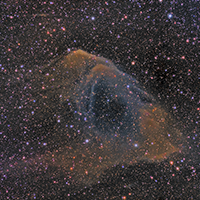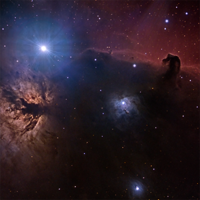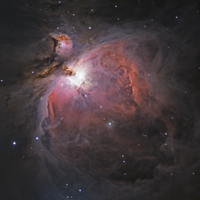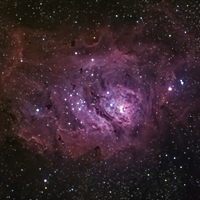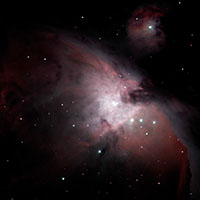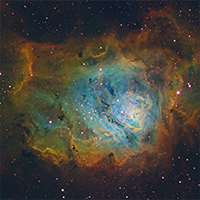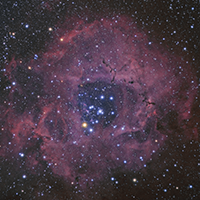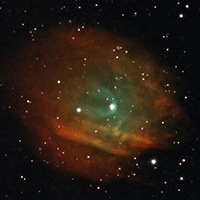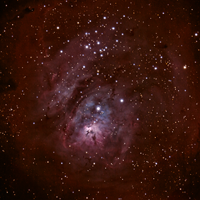Tagged: Sharpless
02-Aug-2025
A swirl of stellar creation, the Trifid Nebula (M20) reveals its dual personality here: rose-pink hydrogen emission framed by the cool, silvery glow of reflected starlight. Dark dust lanes slice the central cloud into three, giving the nebula its name and lending a dramatic floral symmetry.
29-Sep-2022
When stars like the Sun are near end of life, they send their outer layers into space to create glowing clouds of gas, a planetary nebulae. This ejection of mass is uneven, and planetary nebulae can have complex shapes. This dying star is moving rapidly through space, resulting in a long tail of ionized hydrogen gas.
30-Mar-2022
Although categorised as a hydrogen emission nebula, Sh2-63 lacks the bright red colouring typical of similar objects.
04-Jan-2017
Adjacent to the bright blue supergiant star Alnitak shines the ionised hydrogen of the Flame and Horsehead nebulae.
02-Dec-2016
The Orion Nebula is one of the brightest nebulae in the sky, visible to the naked eye. It is seen as the fuzzy middle star in the sword of Orion. The nebula is 1344 light years away and is one of the closest star forming regions to Earth.
03-Aug-2016
Almost everyone has a go at imaging the Trifid nebula, which is composed of 3 different type of nebulae; emission, reflection, and absorption. When I noticed some faint red glow in the background, I decided to try integrating some long hydrogen emission line frames to see if I could get any structure out of it. I'm quite happy with the resulting background structures!
10-Jun-2016
I was lucky enough to snag a second hand 900mm refractor at a good price. I needed a bright target to test it with. The Lagoon Nebula is a giant interstellar cloud around 4077 light years away, classified as an emission nebula and as an H II region.
19-Sep-2015
My original target was the Helix Nebula, but after spending most of Saturday night trying to work out how to use off axis guiding, I gave up and noticed Orion was rising. A nice bright target to use the drift aligned mount on.
27-Aug-2019
The Lagoon Nebula is an active stellar nursery spanning 60 light years across. This false color photograph shows the interplay of three gasses: hydrogen-alpha in green, sulfur-II in red, and oxygen-III in blue.
21-Jan-2018
The Rosette Nebula is an emission nebula 3000 light years away. The central area of the nebula contains an open cluster of hot, blue stars which have cleared much of the center of its gas.
16-Jun-2016
Narrowband images are rarely presented as true color light. When imaging in narrowband, colors are assigned to each channel based on the specific emission lines captured. One of the most common choices is the SHO Hubble Pallet, but the choices for mixing colors are endless. Here are 9 examples of how an image of a planetary nebula may be colored.
10-May-2016
For my first foray into narrowband imaging, I have chosen a very dim & difficult target: planetary nebula Sh2-313, also known as Abell 35 and PK 303+40.1
03-Dec-2015
Cloudy nights and full moons gave me a chance to have another look at one of my first deep sky photographs. The first image taken through my telescope that made me say "wow". I decided to try reprocessing the original data with the skills I've learned in the past few months.
11-Dec-2015
Often I like to see how an image is processed from start to finished. Presented in this animation are the main processing steps in sequence from my reprocessed image of the Lagoon Nebula.


